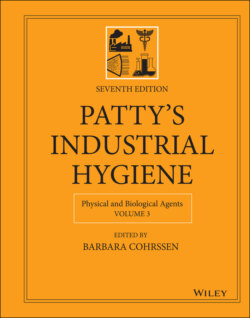Читать книгу Patty's Industrial Hygiene, Physical and Biological Agents - Группа авторов - Страница 140
6.2 Welding, Cutting, and Brazing
ОглавлениеArc welding produces intense radiation across the optical spectrum, from near‐IR to UV‐B and UV‐C. Erythema (similar to sunburn) and photokeratoconjunctivitis (“welder's flash”), a painful inflammation of the cornea and the lining of the eyelid, are common acute effects of overexposure to UV‐B and UV‐C from welding arcs (69). Arc welders could be at increased risk of skin and ocular cancers due to their high UV‐B and UV‐C exposure (70). Thermal burns from hot metal during welding could contribute to this risk (71). Repeated eye burns among welders have been found to be associated with the risk of ocular melanoma (72). High levels of ozone may also be generated during gas shielded arc welding (73).
Requirements for eye and face protection and protective clothing for welders were established by the American Welding Society (AWS) in the ANSI Z49.1:2012 standard, Safety in Welding, Cutting, and Allied Processes (74). The UV output of the welding process depends upon the type of welding, the material being welded, and the arc current. The appropriate eye protection filter for the welder is specified in the ANSI Z49.1 standard by shade number based on characteristics of the welding process. Welding helmets with autodarkening filters enable welders to see through the filter under ambient light while they position their work and strike the arc. A light sensor then detects the arc flash and activates an electronic device that causes a liquid crystal filter to switch from light to dark. This eliminates the old practice by some welders, who left their welding helmets flipped up until the arc was struck (62). Practitioners should ensure that equipment in use meets the requirements of the table titled “Switching Index Requirements for Automatic Darkening Welding Filter Lenses” that was provided in ANSI/ISEA standard Z87.1‐2015 (75).
FIGURE 11 A welder wears helmet, gloves, heavy jacket, and cap with neck drape.
Source: Photo by OSHA.
Protective clothing is required to protect the skin from radiation as well as other hazards of welding, including ignition, sparks, and electric shock. An example of good coverage by protective clothing is illustrated in Figure 11. Workers such as maintenance and repair personnel, whose main job function is not welding, sometimes neglect to use adequate skin protection during welding tasks. Care should be taken to ensure that workers who do not routinely perform welding are aware of the need for skin protection. Full‐time welders, too, might occasionally put themselves at risk by forgoing some protective clothing, as illustrated in Figure 12 (76).
FIGURE 12 A welding technician neglects to wear UV‐absorptive gloves while repairing an aluminum‐lithium weld.
Source: Photo by NASA (76).
In addition to the exposure to the welding operator, the arc and reflections from the arc present a hazard to assistants and bystanders. Guidance on the safe viewing distance for bystanders to control UV hazards to the skin and eye is available from AWS (77, 78). Another control measure for the protection of bystanders is to surround the welding operation with curtains. Transparent plastic welding curtains containing suitable dyes can attenuate both UV and hazardous blue‐light radiation to acceptable levels while still providing sufficient visibility of the welding process to allow visual supervision by a bystander (79).
